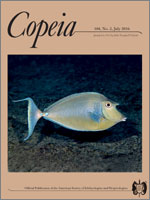Population genetic data are an important standard with which to gauge demography and gene flow within and among biodiversity units, and are often gathered on species of conservation concern. Yet an exclusive focus on ‘conservation immediacy' can also have negative consequences. For example, it can shift monitoring efforts away from more abundant and/or widely distributed clades and, by so doing, promote a more myopic approach to conservation and management. A current example concerns North American pitvipers (Viperidae: Crotalinae), within which listed species of Crotalus and Sistrurus receive considerable population genetic attention whereas broadly distributed Agkistrodon is largely overlooked. To address this disparity, we used 22 polymorphic tetra-nucleotide microsatellite loci to explore genetic structure, diversity, and relatedness in a Connecticut population of Copperhead (A. contortrix). Three admixed genetic clusters were identified across five winter dens, with overall and sex-specific relatedness similar among dens and across the population. First- and second-order relationships were identified within the population, then juxtaposed against known den associations. Values for genetic structure, diversity, and effective population size are similar to those reported for populations of North American Crotalus and Sistrurus. However, the study population did not sustain a genetic bottleneck following recent anthropogenic habitat alterations, and this may reflect a potential resilience to environmental change, particularly when compared with North American Crotalus and Sistrurus. Our results underscore the importance of (1) quantifying population-level parameters in non-threatened crotalines so as to broaden and extend our understanding of anthropogenic impacts, and (2) evaluating population genetics in taxa that appear superficially resilient to anthropogenic modifications. The latter may also promote valuable comparative analyses with threatened and endangered taxa.
BioOne.org will be down briefly for maintenance on 17 December 2024 between 18:00-22:00 Pacific Time US. We apologize for any inconvenience.
How to translate text using browser tools
9 June 2016
Population Genetics of the Copperhead at Its Most Northeastern Distribution
Brenna A. Levine,
Charles F. Smith,
Marlis R. Douglas,
Mark A. Davis,
Gordon W. Schuett,
Steven J. Beaupre,
Michael E. Douglas
ACCESS THE FULL ARTICLE





